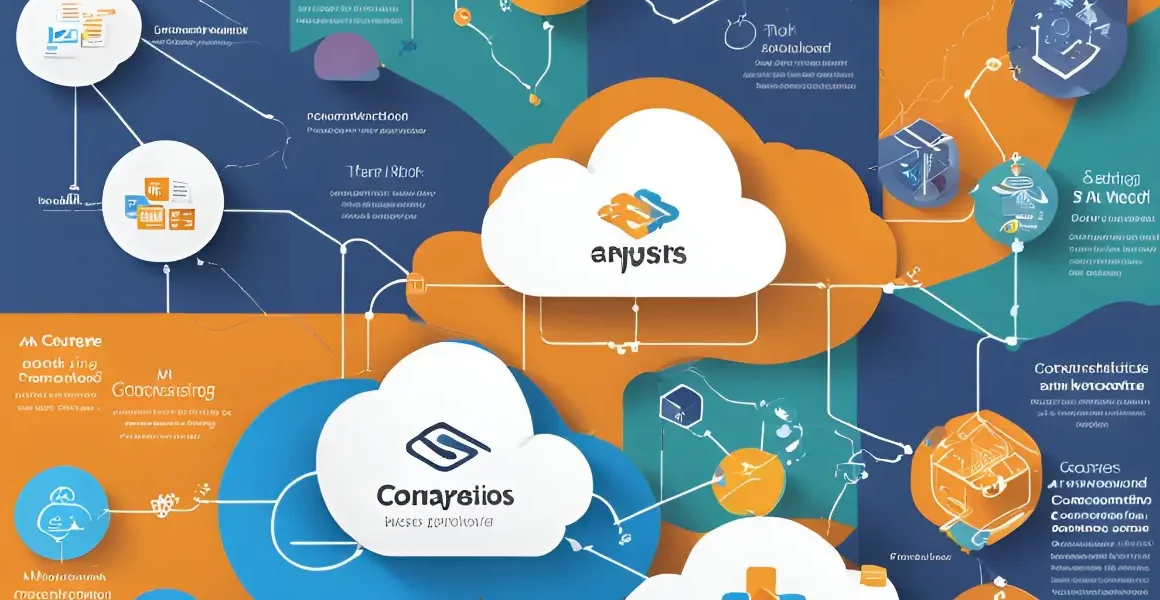
Cloud computing is a term that has become progressively well known as of late, yet many individuals actually may not completely comprehend what it involves. Basically, cloud computing alludes to the conveyance of computing services over the web, permitting clients to get to and use a scope of applications and assets without the requirement for their own actual hardware. This really intends that, as opposed to storing data or running programmes on a personal computer or local server, people and organisations can take advantage of cloud services given by outsider providers.
1. What is cloud computing?
Cloud computing is a term that we are hearing an ever-increasing number of nowadays, yet what does it truly mean? In basic terms, cloud computing alludes to the act of utilising a network of far-off servers facilitated on the web to store, manage, and process data, as opposed to utilising a local server or a personal computer.
Think about it along these lines: rather than storing your files and running applications on your very own computer or server, you can get to them over the web through a service provider. This service provider keeps up with the hardware, software, and infrastructure expected to run these applications and store your data, so you don’t need to stress over overseeing or keeping up with it yourself.
Cloud computing can take various structures, from essential storage services like Dropbox or Google Drive to further developed computing services like Amazon Web Services or Microsoft Azure. These services permit you to get to assets like virtual servers, databases, and software applications on-demand without the need to put resources into or manage your own actual hardware.
One of the critical benefits of cloud computing is flexibility. With cloud services, you can increase your assets or down in light of your necessities, paying only for what you use. This can be especially valuable for businesses that have fluctuating demand or need to carry out new applications or services rapidly.
One more benefit of cloud computing is accessibility. Since your data and applications are stored in the cloud, you can get to them from any gadget with a web connection. This implies you can work on the go, team up with others continuously, and access your information from anyplace on the planet.
Cloud computing additionally offers preferred security over traditional on-premises solutions. Cloud providers put vigorously into security measures to safeguard their customers’ data, including encryption, firewalls, and multi-factor authentication. This can give you true serenity, realising that your information is free from even a hint of harm.
In addition to flexibility, accessibility, and security, cloud computing likewise offers cost savings. By re-appropriating the management of your IT infrastructure to a service provider, you can lessen the requirement for in-house specialised staff and lower your general IT costs. This can let loose assets to put resources into different regions of your business, similar to innovation and development.
By and large, cloud computing is revolutionising the manner in which we store, manage, and access data and applications. By utilising the force of the web and distant servers, organisations, all things considered, can benefit from the scalability, accessibility, security, and cost savings that cloud computing gives.
2. How really does cloud computing work?
At its centre, cloud computing includes storing and getting to data and programmes over the web rather than on your computer’s hard drive. “Cloud” in cloud computing alludes to the network of servers that are utilised to store and manage this data. These servers are housed in data revolves found from one side of the planet to the other.
At the point when you use cloud computing services, for example, Google Drive or Dropbox, you are basically re-appropriating the storage and management of your data to these servers. This implies that you can get to your files from any gadget with a web connection without stressing over actual storage limitations.
how precisely does the most common way of storing and recovering data in the cloud work? We should investigate.
At the point when you transfer a record to a cloud computing service, for example, a document or a photo, it is separated into more modest bits of data called packets. These packets are then sent over the web to a distant server in a data community. The server stores these packets in different locations on its hard drive.
At the point when you need to get to the document later on, the cycle is switched. Your gadget sends a solicitation to the server, requesting the particular packets that make up the document. The server recovers the mentioned packets and sends them back to your gadget, where they are reassembled into the first document.
This course of separating data into packets and sending them over the web is known as data transmission. It is a central piece of how data is moved in cloud computing.
One more key part of cloud computing is virtualization. Virtualization permits multiple virtual servers to run on a solitary actual server. This implies that a solitary actual server can have multiple virtual servers, every one of which can be utilised by various clients or applications.
Virtualization empowers cloud computing providers to distribute assets all the more proficiently, as they can progressively change how much handling power, storage, and memory are doled out to each virtual server in view of demand. This considers more noteworthy flexibility and scalability in cloud computing services.
In addition to storage and virtualization, cloud computing likewise includes different layers of software that manage the assets and services given by the cloud. These software layers incorporate the working framework, middleware, and applications that facilitate the communication between your gadget and the far-off servers.
3. Benefits of utilising cloud computing.
One of the greatest benefits of utilising cloud computing, first and foremost, is cost savings. Traditional on-premise infrastructure regularly requires critical upfront interests in hardware, software, and IT personnel to manage and keep up with the frameworks. In contrast, cloud computing works on a pay-more-as-costs-arise model, permitting businesses to only compensate for the assets and services they really use. This wipes out the requirement for exorbitant hardware redesigns and decreases operational costs connected with upkeep, energy consumption, and cooling. Additionally, the scalability of cloud services empowers businesses to effectively change their assets in light of fluctuating demand, at last advancing expenses and amplifying efficiency.
One more significant benefit of cloud computing is expanded flexibility and agility. Cloud services give businesses the ability to get to data, applications, and services from anyplace with a web connection, empowering representatives to consistently work remotely or team up on projects. This flexibility upgrades representative productivity and satisfaction as well as permits businesses to adjust rapidly to changing market conditions and consumer demands. With cloud computing, businesses can quickly convey new services or scale existing ones without the postponements and complications related to traditional IT infrastructure. This agility empowers businesses to remain competitive in the present speedy digital scene and immediately respond to emerging trends and opportunities.
Finally, cloud computing offers improved security and data protection. Cloud service providers put vigorously into state-of-the-art security measures, like encryption, firewalls, and multi-factor authentication, to shield their clients’ data from cyber threats and breaches. These providers additionally carry out customary security audits and consistency certifications to guarantee that data is stored and transmitted safely. In addition, cloud services offer programmed reinforcement and fiasco recuperation capabilities, lessening the risk of data misfortune because of hardware disappointment, human blunder, or catastrophic events. By utilising cloud computing, businesses can have confidence that their data is protected, secure, and supported, permitting them to focus on their centre operations and key initiatives.
In conclusion, cloud computing offers a great many benefits that can assist businesses with smoothing out operations, incrementing efficiency, and driving development. From cost savings and flexibility to security and scalability, cloud services give a competitive edge in the present digital economy. By embracing cloud computing, businesses can use the force of technology to advance, team up, and flourish in an undeniably interconnected world. Whether you’re a little beginning up or a large endeavour, cloud computing can revolutionise the manner in which you carry on with work and push you towards progress.
Frequently Asked Questions (FAQ) About Cloud Computing
Q: What is the main difference between cloud computing and traditional computing?
A: Cloud computing allows you to access data and applications over the internet, while traditional computing relies on local hardware and servers. With cloud computing, you only pay for what you use and can access resources from anywhere with an internet connection.
Q: Is cloud computing secure?
A: Yes, cloud computing is generally very secure. Cloud providers invest heavily in security measures including encryption, firewalls, and multi-factor authentication. They also regularly update their security protocols and comply with international security standards.
Q: How much does cloud computing cost?
A: Cloud computing costs vary based on usage and service level. Most providers use a pay-as-you-go model, meaning you only pay for the resources you actually use. This can include costs for storage, processing power, and additional features.
Q: Can small businesses benefit from cloud computing?
A: Absolutely. Cloud computing is particularly beneficial for small businesses as it eliminates the need for expensive hardware investments and IT staff. It provides scalability, flexibility, and enterprise-level tools at a fraction of the traditional cost.
Q: What happens if I lose internet connectivity?
A: Without internet connectivity, you cannot access cloud services. However, many cloud applications offer offline modes that allow you to continue working, with changes automatically syncing once the connection is restored.
Q: Can I switch between cloud providers?
A: Yes, you can switch between cloud providers, though this process (called cloud migration) requires careful planning. It’s important to consider data transfer costs, compatibility issues, and potential downtime during the migration.
Q: What types of cloud computing services are available?
A: The main types are:
- IaaS (Infrastructure as a Service)
- PaaS (Platform as a Service)
- SaaS (Software as a Service)
- Each type offers different levels of control and management over your cloud resources.
Q: How does cloud computing help with disaster recovery?
A: Cloud computing provides automatic backup and disaster recovery capabilities. Your data is typically stored across multiple locations, ensuring business continuity even if one location experiences problems.



